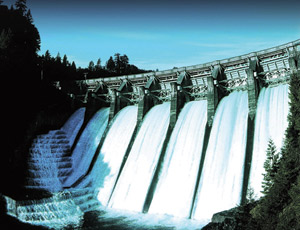BC Hydro, the state-owned electric utility in British Columbia and Canada’s third-largest power company, is investing more than $6 billion to upgrade its transmission, generation and distribution systems, the firm announced late last month. The Burnaby, British Columbia-based utility has under way or is about to begin more than a dozen major capital projects throughout the province, including an upgrade to the 105-MW Ruskin hydroelectric plant near Vancouver.


The project, valued between $718 million and $857 million, is set for completion in 2018. BC Hydro supplies power to 95% of residents in the province.
The complex upgrade will involve three major projects, all staged to not interfere with one another, says Boyd Mason, BC Hydro senior project manager. The projects will improve the dam’s ability to withstand potential seismic events, repair a longstanding problem with seepage in the right abutment, and replace the powerhouse and turbines, which “simply wore themselves out,” he says.
The job is made more complex because of the dam’s small footprint and the simultaneity of the three projects, Mason says. “We have limited laydown area for the contractor forces,” Mason says. The dam also must maintain water flow during construction to protect the fish downstream, he says.
First, contractors will install a plastic membrane in the dam’s right abutment to resolve the long-known seepage problems. BC Hydro currently is working separately with two contractors—Matcon Civil Contractors, Langley, British Columbia, and Burnaby-based GAIA Contractors—to determine the best design.
Next, the utility will award by year’s end a design-build contract to one firm for the work, which is set to begin in 2012 and be completed in July 2013, Mason says. Because of the project’s sensitive nature, no other major earthwork construction will occur until the abutment work is done, he adds.
BC Hydro will then award a design-build contract for the dam’s pier and spillway gates; that work is expected to begin in 2013 and be completed in 2017. Crews will demolish existing gates and piers, replacing with five gates the current seven, in three stages. Further, the contractor will replace the single-lane road now crossing the dam with a two-lane road.
Finally, crews will rebuild the powerhouse to withstand the potential seismic threat in the province and replace turbines. The utility already has issued a request for proposals for the turbine replacement.
According to Mason, the dam’s limited water flow will generate only minor increases in electricity production, to an estimated 114 MW. But he says the upgrade is necessary to protect the safety of the downstream population and to supply power to metropolitan Vancouver, which has a current population of about 2.3 million.
Also under way as part of the capital investment plan are major upgrades to the G.M. Shrum and Revelstoke dams. BC Hydro says those two dams supply about 24% and 21%, respectively, of its installed generation capacity.
The utility also is upgrading and building four major transmission lines, replacing 64,000 distribution poles and 400 kilometers of underground or submarine cables. Furthermore, the company plans to install “smart” meters in 1.8 million provincial homes. BC Hydro will spend some of the capital budget on “Site C,” a proposed 900-MW hydroelectric dam on the Peace River that has been estimated to cost $6.6 billion.
The projects will upgrade an aging electric system—built between the 1950s and the 1980s—that has seen very little investment in maintainance in the last 10 to 15 years, said Dave Cobb, BC Hydro CEO and president, in a Feb. 22 conference call. He pointed to the recent earthquake in New Zealand as a reason for the seismic upgrades.
However, to pay for the work, electric rates will almost double for BC Hydro customers, Cobb told customers in a March 1 letter. “It would cost British Columbians more in the future if we neglect these assets now when you consider the risk of power outages and the risks to public and employee safety, not to mention the cost of corrective maintenance and emergency repairs,” he wrote. “Delaying these projects into the future will not make the need to invest in our electricity system go away. We are proceeding only with the most important projects at this time.”
Cobb also said the capital improvements are necessary to meet an anticipated 40% load growth over the next 20 years for a provincial population set to increase by one million. The utility has a power capacity of about 11,500 MW, approximately 10,260 MW of which comes from hydroelectric sources.
BC Hydro is posting information related to project requests for proposal at http://www.bcbid.gov.bc.ca/open.dll/welcome

Post a comment to this article
Report Abusive Comment